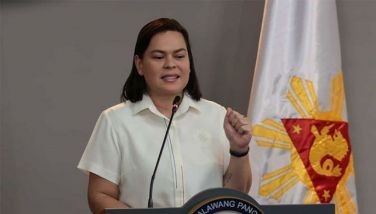Tikad-kaalam: Language, dances, peace
Developing knowledge through a forum on language, dance and peace-making is bridging to understanding human development. Such initiative could be experienced among students in an academic institution that puts premium on knowledge acquisition and dissemination.
I am privileged to be part of the panel of reactors in what could be characterized as an academic forum highlighting the use and importance of local language, dances and peace-making. Dubbed "Tikad-kaalam", it all started with an invitation from the organizer and prime mover Sister Geraldine D. Villaluz, RSCJ, that made my September 8, 2014 truly a day of knowledge acquisition and wonderful sharing. It was a fitting tribute as we celebrated the birthday of Mother Mary and the entire women whose role in the society is unmatched. I would also thank Dr. Antonio Batomalaque, Dean of the College of Education, for the great opportunity.
First to share is my fellow member of the Komisyon Probinsiyal sa Sinugboanong Pinulongan and Chair of the Department of Teacher Education Dr. Cristie Ann J. Delfin. In her study titled "Pinulongan: Panglantaw sa mga Katiguwangan," she gave an overview of the language and its uses and importance according to the society's elderly. She accentuated the idea that using the local language in teaching makes learning easier and meaningful.
Mr. Mariano Garcia's "Mga Sayaw sa Asya: Pagtudlo ug Paglantaw sa mga Sugbuanong Magtutudlo" tackles on the dances of the Southeast Asian nations and their inclusion in the Physical Education curriculum. But the reality bites: the very limited exposure of our teachers and the inadequacy of dance literature. Teachers are heavily relying on videos from the Internet. This is indeed a challenge as we need to double our efforts to keep up with the title of Cebu as ASEAN City of Culture.
Mr. Marlon T. Bojos' "Descriptive Characteristics of Sinulog Dance of Cebu" undertakes the power of faith as manifested in dance movements. His study tracks the history of Sinulog and its evolution and various interpretations from early prime movers until the present believers. He mentioned the pillars of Sinulog such as the late Mr. Mike Gonzales, Mrs. Dolly Suzara, and the only ethnographer in Cebu, Mr. Caesar Nimor, among others.
Mrs. Astrid G. Ocampo's "Pastores de Sibonga" talks about a short Christmas play which narrates the story of Christ's nativity. Dating back to the 1920s, the play depicts the shepherd's adoration of the child Jesus. The lyrics tell of the pre and post nativity settings that express great happiness, joy and worship through offerings and praises for Jesus, Mary and Joseph.
It was heartwarming to know that Mrs. Ocampo has a script of the whole narrative from the old performer Violeta Sumalinog, who is now blind. It is likewise disheartening on the other hand that there seems nobody is following this tradition.
Sister Geraldine D. Villaluz, RSCJ, in her "Kalinandang sa mga Nanay Talaandig: Unod sa Edukasyon Alang sa Kalinaw" featured the Inay Malinandang in Mount Kitanglad in Bukidnon and their opinions on how to establish true peace in the community. The mothers who are popularly called Inay Malinandang from the word kalinandang meaning peace were asked about establishing peace through education.
The Talaandig women work to deepen understanding of the conflict and enhance support for peace through community forums, interfaith dialogs and radio programs. Such initiatives have helped build a peace process wholly owned by those communities most affected by the conflict. Women have big role and enjoy great respect in their tribes. They are regarded as mothers of the entire Talaandig.
They respond to critical situations and contact decision makers to defuse volatile situations. They are more open to engaging with other groups in the name of peace, not like before. For them, peace can be achieved not only when there is conflict resolution but also when there is food security, good health, proper education, brotherhood and recognizing their ancestral domain.
Foremost in understanding who we are and what we aspire to be is a deliberate effort of knowing our past and valuing it, a major condition for achieving human development. It is therefore about upholding our rich language, culture and tradition that makes who we are, truly an identity that is only ours.
- Latest
























